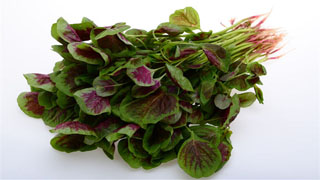
June has also come to an end, and July is approaching. The temperature is getting higher and higher, and it is always in a sweaty state. At this time, elderly people should supplement potassium appropriately.
Potassium is a key mineral in the human body that participates in regulating the contraction and relaxation of heart muscles, helping to maintain normal heart rhythm and blood pressure. It is also the "nemesis" of hypertension, hyperlipidemia, and hyperglycemia!
As the saying goes, "May amaranth is the right time, June amaranth is like an egg, and July amaranth is as valuable as gold." This shows the love and recognition of amaranth by many people. Amaranth not only has a delicious taste, but also has the title of "longevity vegetable", which contains rich nutrients such as potassium and folic acid, which is very beneficial to human health!
Don't miss out on the "three highs" crowd
Amaranth is sweet and cool, with effects such as clearing the lungs and replenishing qi, clearing heat and diuresis, clearing the liver and improving eyesight. The content of various nutrients is among the top in common vegetables.
1. "Folic acid champion"
There is a nutritional element that can be called an aging agent for blood vessels and the brain, but one out of every five people lacks it! It is folic acid.
In fact, compared to pregnant women, middle-aged and elderly people need to supplement more!
For individuals with hypertension and hyperlipidemia, supplementing with sufficient folic acid can enhance vascular elasticity, improve endothelial function, and prevent thrombosis and stroke.
Folic acid can also promote the development and repair of brain nerves, reducing the damage of harmful substances to cerebral blood vessels. Moderate supplementation of folic acid for middle-aged and elderly people can help strengthen the brain, enhance intelligence, and prevent dementia.
Among common vegetables, amaranth ranks among the top in folate content, reaching about 420 micrograms/100 grams, which is 46 times higher than cucumber! Such cheap and nutritious vegetables should be bought more during the season!
2. Stable blood pressure
Moderate potassium intake can help dilate and relax blood vessels, thereby reducing vascular resistance, reducing the burden on the heart, and stabilizing blood pressure.
The potassium content of amaranth is also very impressive, reaching about 340 milligrams per 100 grams, which is higher than seaweed. Moderate consumption can help protect the heart and assist in regulating blood pressure.
In addition, the fiber and various vitamins rich in amaranth can also play a role in reducing blood lipids and cholesterol levels, which is of great help in preventing cardiovascular diseases.
3. "Expert" in calcium supplementation
Many people rely on drinking milk and bone soup to supplement calcium, but in fact, some green leafy vegetables are the true "masters" of calcium supplementation, such as amaranth.
The calcium content in every 100 grams of amaranth is about 187mg, which is three times that of spinach and more than 1.5 times that of milk! Eating regularly can promote bone development and enhance bone health.
4. Nourishing blood and improving eyesight
Amaranth is rich in nutrients such as iron, folic acid, and vitamin C, which play an important role in nourishing blood. So for people with iron deficiency anemia, consuming amaranth is very beneficial.
Amaranth is also rich in vitamin A, which is beneficial for visual health, so it is suitable for elderly people to consume.
5. Runchang laxative
Amaranth is rich in various dietary fibers, which can promote gastrointestinal peristalsis after consumption, help promote normal digestion process, prevent constipation and other digestive problems.
6. Strengthening the body and reducing inflammation
Amaranth is rich in vitamin C, vitamin E, carotenoids, and various antioxidants, which help neutralize free radicals, alleviate oxidative stress, and have anti-inflammatory effects. Summer heat can easily cause people to get overheated and increase body heat, while consuming amaranth can clear heat and detoxify.
Amaranth is Kwai and delicious
Amaranth leaves are soft and have a light aroma. The way to eat it is very simple, and with some garlic stir fry, it can be very delicious. Red amaranth comes with a natural red color and can also be used to color food.
Garlic and Amaranth
Ingredients: Amaranth, garlic
Method:
1. Cut chopped scallions, ginger, and garlic, blanch amaranth quickly, and then cut into sections.
2. Heat up a wok with cold oil, stir fry scallions, ginger, and garlic, then add amaranth and stir fry.
3. Add chopped garlic again, add an appropriate amount of salt and stir fry well to remove from the pot.
Amaranth and Tofu Soup
Ingredients: 400g of amaranth, 20g of boiled sea rice, 250g of tofu, and 10g of garlic.
Method: Wash amaranth, blanch it in boiling water, remove and drain; Minced water and sea rice; Cut tofu into small pieces and mash garlic into paste; Heat the wok over heat, add cooking oil, heat up the oil, add garlic puree, stir fry until fragrant, add sea rice and tofu chunks, simmer with a little salt for 1 minute, then add water and an appropriate amount of salt; Bring the soup to a boil, roll the amaranth and remove it from the heat. Serve in a bowl with seasoning.
Stir fried eggs with amaranth
Ingredients: amaranth, eggs, garlic, oyster sauce, salt
Method:
1. Wash and cut amaranth into sections, mince garlic, add a little salt to the eggs, and mix well.
2. Heat up the oil in a hot pot, pour in the egg mixture, scatter and serve.
3. Leave the bottom oil in the pot, add garlic and stir fry until fragrant, add amaranth and stir fry until soft, then add eggs and mix well. Add a little salt and oyster sauce and stir fry well.
The difference between red leaf amaranth and green leaf amaranth
There are generally two common types of amaranth: red and green. Green amaranth has a better heat clearing effect, red amaranth is more blood nourishing, and it also contains antioxidant anthocyanins. The purple color of amaranth juice is the result of the combined action of a large amount of anthocyanins and a small amount of other pigments.
Overall, there is not a significant difference in nutrition, and people can choose according to their preferences and convenience of purchase.
These things need to be noted
1. Selection Techniques
Fresh amaranth is prone to breaking when pinched by hand, with fewer and shorter roots, and a tender and crispy taste. In addition, amaranth leaves with dark colors are mostly grown in outdoor environments, which are more nutritious.
2. Blanch before eating
The oxalic acid content in amaranth is relatively high, which is not conducive to the absorption of calcium. Before consumption, it is recommended to quickly blanch in boiling water before proceeding to the next step of cooking.
In addition, folic acid in amaranth is a water-soluble nutrient that can be lost due to high temperature and salinity. So when eating amaranth, try not to cook it for too long and add too much salt.
3. These people are not suitable for eating too much
Kidney disease patients: Amaranth is rich in potassium. For patients with renal insufficiency or dialysis, excessive intake of potassium may lead to hyperkalemia, which has a negative impact on their health.
Allergic constitution: Amaranth is a photosensitive vegetable. Some people with allergic constitution may experience allergic reactions such as skin turning purple, itching, burning, and diffuse swelling after consuming it under sunlight. This phenomenon is medically known as "plant-based sunburn dermatitis".
Early pregnancy: According to "Dietary Therapy Materia Medica", "Amaranth and purslane are fine powder, divided equally, and taken regularly with pregnant women to facilitate childbirth." This means that for expectant mothers in early pregnancy, consuming amaranth can easily lead to miscarriage.


